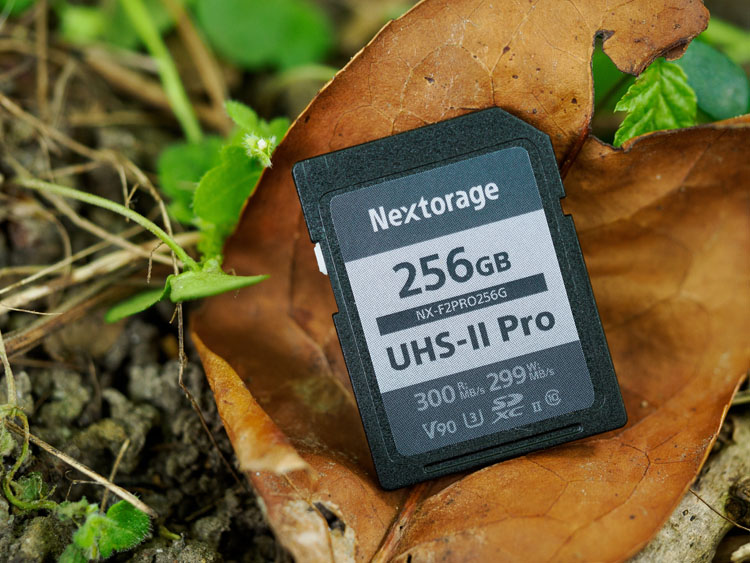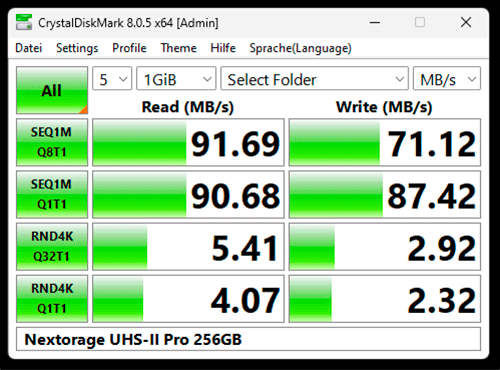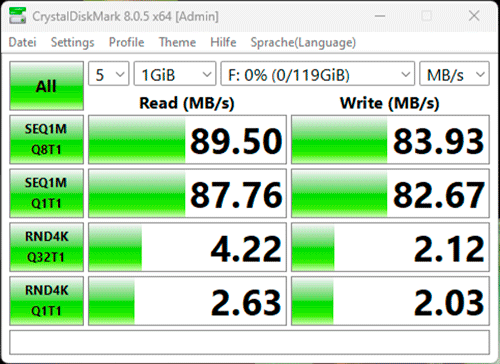06 Aug Review: Nextorage NX-F2PRO UHS-II U3 V90 SDXC Memory Card for Macro Photography

Wildlife Photography, and Extreme Macro Photography in particular, when Focus Bracketing and Stacking as well as continuous shooting is involved, requires a fast camera buffer and also a fast memory card.
I was curious if I could get a significant increase in working speed if I upgraded to a high speed U3 V90 SD Memory Card, to use with my OM SYSTEM OM-1 II.
After some web research, the Nextorage UHS-II Pro U3 V90 SDXC Card seemed like the fastest card available, so this is what I am currently testing, in the 256 GB version.
The japanese Company Nextorage was founded in 2019 by a team of SONY engineers with 20 years of history in memory storage.

The specifications
Max. speed (Read) 300 MB/s
Max. speed (Write) 299 MB/s
Warranty
Valid for 5 years from the purchase date


- Water proof IPX7
- Dust proof IP5X
- Shock resistance (height from 4.9 ft (1.5 m))
- Bending resistance 10 N
- Connector mating 10,000+ cycles
- Storage temperature range -25C to 85C / -13℉ to 185F (Non-condensing)
- X-ray resistance ISO7816-1
- UV resistance ISO7816-1
- Electrostatic resistance IEC61000-4-2
- Anti-Magnetic
The Nextorage UHS-II Pro U3 V90 SDXC in a nutshell
When it comes to the specifications of the NX-F2PRO Series pSLC NAND memory card, there is no doubt that it is a powerful one.
With the V90 standard it guarantees a minimum transfer rate of 90 MB/s.
It supports 4K and 8K high-definition video recording and high-speed continuous shooting in RAW quality, which puts it in the highest standard in the SD video speed class.

The packaging for the card is simple: it comes in a nicely branded carboard envelope with the standard plastic case.
No plastics or foil added, so that´s a plus – I like when packaging does not use plastics and stays as sustainable as possible.
Which modes of the OM-1 II benefit from a fast SDXC memory Card?
Basically all functions and modes that rely on the buffer will benefit from a fast Memory Card.
Whenever it is about speed or computational photography features, a quality card is important.
If you ever needed to wait for your camera to empty the buffer or finish an operation (after taking a focus stack for example), then this is exactly where a fast Card will come into play.
The actual process of unloading the buffer(ed images) – onto the card – will be sped up with a fast card, and you will be ready faster to shoot the next Focus Stack, for exmaple.
- Focus Bracketing
- Focus Stacking
- ProCapture
- High fps modes SH1 and SH2
- HighRes
Using the Nextorage UHS-II Pro U3 V90 SDXC 256GB
To really make use of the high speeds of your memory card, you have to look at their sustained write speeds and beyond the simple max speed that they are advertised with.
The OM-1 II (like its predecessor OM-1 as well) actively uses the much higher bus speed of the UHS-II mode (on both slots).
On the E-M1 III the top slot supports UHS-II speeds, while the lower slot is UHS-I.


256GB of size may sound a bit too much for a memory card if you are only shooting single images, however, if you are doing a lot of deep focus brackets and stacks, a card can fill up pretty quickly.
The same goes for ProCapture and simply all the modes that rely on producing a lot of files in a short amount of time.
If you are using a computational camera feature like focus bracketing or stacking, the buffer will not just have more time until it fills up, it also empties again faster, so you can start a new stack or bracket even faster as well.
That is two big plus points for me!
What really matters to use the full power of a U3 SDXC
On paper the Nextorage UHS-II Pro U3 V90 SDXC is an impressive workhorse.
Looking at laboratory tests and also those with state-of-the-art card readers, there is no question that the speed of the card is on the absolute top end of what is possible.
Although it is a top performer even with hardware that offers only U2 speed (slower USB standards), regarding the read speed, this ultimately reveals the bottle neck in using this card: you really need a U3 compatible Card reader and also connect it via a USB slot that is fast enough for the U3 speed.
This means you have to read the card preferably via a USB Type C port (USB 3.x standard).
Technically USB standards will provide the following speeds:
- USB 3.0 – 5GBit/sec = 625 MB/s
- USB 3.1 10GBit/sec = 1250 MB/s
- USB 3.2 – 20Gbit/sec = 2500 MB/s
- USB 2.0 = 480 Mbit/s
On paper, even a USB 2.0 port should give you enough reading speed.
In practice, these speeds are rarely or never achieved, so you would need at least the USB 3.0 standard.
CrystalDiskMark 8 Testing
Notice: I have tested various variations of readers and ports and also added some other cards for comparison but please be aware, that i did not test in laboratory conditions and also not in the best hardware-combinations that are available and will provide even better results.
The Nextorage NX-F2PRO UHS-II Pro 256GB SDXC Memory Card
Card: Nextorage UHS-II Pro 256GB
Card Reader: DELL XPS 15 internal SD Card reader slot:


Card: Nextorage UHS-II Pro 256GB
Card Reader: UGREEN USB C 312MB/S SD 4.0
USB-C port (DELL XPS 15)


Card: Nextorage UHS-II Pro 256GB
Card Reader: AXAGON Dual-Slot 5Gb/s USB-C 3.0/USB-A 3.0
USB-C port (DELL XPS 15)

Card: Nextorage UHS-II Pro 256GB
Card Reader: AXAGON Dual-Slot 5Gb/s USB-C 3.0/USB-A 3.0
USB port (DELL XPS 15)

Other SD Cards for comparison
Lexar Pro UHS-II V60 128GB 250mb/s
Card: Lexar Pro UHS-II V60 128GB 250mb/s
Card Reader: DELL XPS 15 internal SD Card reader slot:

Card: Lexar Pro UHS-II V60 128GB 250mb/s
Card Reader: UGREEN USB C 312MB/S SD 4.0USB-C port
USB-C port (DELL XPS 15)

Card: Lexar Pro UHS-II V60 128GB 250mb/s
Card Reader: AXAGON Dual-Slot 5Gb/s USB-C 3.0/USB-A 3.0
USB-C port (DELL XPS 15)

Card: Lexar Pro UHS-II V60 128GB 250mb/s
Card Reader: AXAGON Dual-Slot 5Gb/s USB-C 3.0/USB-A 3.0
USB port (DELL XPS 15)

SanDisk Extreme PRO V90 32GB 300mb/s
Card: SanDisk Extreme PRO V30 128GB 200mb/s
Card Reader: DELL XPS 15 internal SD Card reader slot:

Card: SanDisk Extreme PRO V30 128GB 200mb/s
Card Reader: UGREEN USB C 312MB/S SD 4.0USB-C port (DELL XPS 15)
USB-C port (DELL XPS 15)

Card: SanDisk Extreme PRO V30 128GB 200mb/s
Card Reader: AXAGON Dual-Slot 5Gb/s USB-C 3.0/USB-A 3.0
USB port (DELL XPS 15)

SanDisk Extreme PRO V30 128GB 200mb/s
Card: SanDisk Extreme PRO V30 128GB 200mb/s
Card Reader: DELL XPS 15 internal SD Card reader slot:

Card: SanDisk Extreme PRO V30 128GB 200mb/s
Card Reader: UGREEN USB C 312MB/S SD 4.0
USB-C port (DELL XPS 15)

Conclusion
The Nextorage UHS-II Pro U3 V90 SDXC Memory Card (256GB) is a beast – no question.
When you push the hardware to the limit, you can feel and see a real difference from the medium class SD Cards.
If you use photography modes which need your shots to be buffered and written quickly I would definitely recommend using such a card if your budget allows it.
Keep in mind that you really need appropriate hardware to make use of the potential of this card – both for the writing speed (camera with U3 card-slot) and for the reading speed (card reader and USB slot).
My CrystalDiskMark 8 test runs clearly emphasized on that.
The most important aspect is the compatibility of your camera.
For computational photography features like extreme focus stacks and continuous/sequential shooting sessions the writing speed is what we want and which matters the most.
Here we benefit from a longer time before our buffer fills up and slows down the photographing process.
Personally, i can live with losing a couple minutes at home when uploading my photos to the computer – so the reading speed is of secondary importance to me.
Still, I will upgrade to a faster internal reader for the computer to keep up with the Nextorage SDXC Card because – why not 🙂
Sign up for the newsletter mailing list & free ebook

Did you enjoy these tips and want to learn more or improve your macro photography skills?
Stay up to date with new blog posts, reviews and tutorial- and ebook-releases.
Sign up below to get notified when the free edition of my ebook
‘How to master spider & insect macro photography’ is ready for download.



No Comments